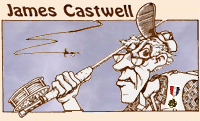|
Frustrating when it happens, but it did. And it had me fooled for a few
casts. My up-stream cast was fine. A gentle breeze was coming in from my right
and the stream was a bit narrow, perhaps eight feet across. The presentation had
to be right on target, and it was. But no hits on the size 16 tan caddis after about
half a dozen casts. I knew there were some fine rainbow and brookies feeding, I
had seen the rings.
It dawned on me finally as I carefully watched the fly drift back to me.
Because the line was almost straight up-stream my fly line was coming
back at me faster than the fly was. As it did this, my fly was starting
to drag almost at once. This was not easy to see due to the distance
and some overhanging grass. I was getting less than a foot of natural
drift and once the fly started to leave any wake it was being refused.
The problem was solved by making a slight adjustment on my up-stream
cast.
Because of the breeze and the narrow stream I had been making a
rather direct cast with little slack at the far end, where the fly was. My cast
had controlled slack, but over it's whole length, not where I really needed
it the most. By making a little less hard cast, more of a wave of the rod,
not as hard a stop, the front loop of leader settled to the water and had more
loose coils which allowed the fly to float free of drag while passing over the fish.
Yes, it did work. The rainbow was only about ten inches long, but I got
him on the very first cast done correctly. I used that method of cast
the rest of the day on Ditch-Creek, South Dakota and it really paid off. The
little things can make such a big difference, and it is not always the fly that is
the problem.
Sometimes you need to be an imitationist, sometimes a presentationist.
Sometimes, just pay attention. ~ JC
|





